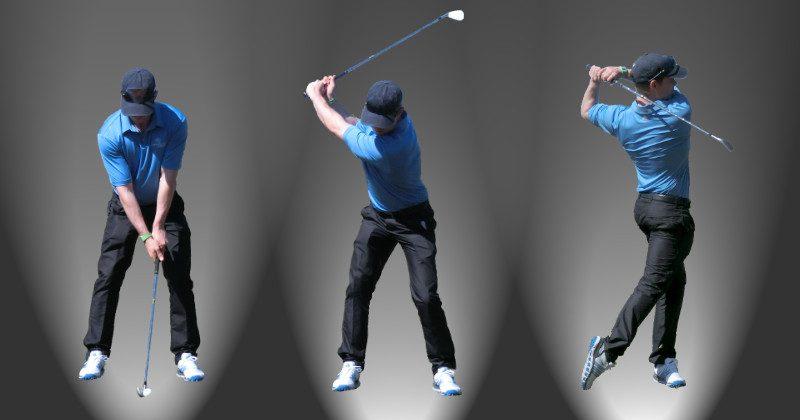Refining Your Golf Swing: A Beginner’s Five-Step Approach
Golf is a sport celebrated for its precision and finesse, where a well-executed swing is essential for sending the ball toward the green. For those eager to master this critical skill, a systematic approach is vital. This detailed guide simplifies the golf swing into five key steps, equipping you with the techniques and insights needed to build a strong foundation and enhance your game.
– Establishing the Ideal Golf Grip: A Key to Success
- Establishing the Ideal Golf Grip: A Key to Success
The grip on your club serves as the foundation of an effective swing, much like how steering controls a vehicle. To create an optimal grip, start by “crunching” your lead hand’s knuckles together to form a pocket for the club. Position this hand beneath the grip and wrap it around securely, ensuring it won’t slip during your swing. Next, add your other hand in either an interlocking or overlapping style; nestle its thumb into the pocket created by your lead hand for enhanced stability. The result should be thumbs pointing downwards with fingers comfortably encircling the grip.
- Initiating Your Swing: The Role of Footwork and Lateral Movement
The initiation of your golf swing begins not with arm movement but through proper footwork. For right-handed players, engaging toes on their left foot prompts a natural push towards their right side while rotating onto their right heel—this instinctive action sets up an effortless backswing. Maintain balanced posture throughout this motion as you smoothly rotate from side to side while feeling lateral pressure shift beneath you; this dynamic becomes crucial in driving your swing forward while allowing arms to respond fluidly.
– Energizing Your Swing Through Effective Footwork
Energizing Your Swing Through Effective Footwork
Foot placement acts as a catalyst that energizes your golf swing by facilitating rotational movement that delivers power and accuracy through impact. Understanding how best to engage these movements is essential for achieving efficiency in each stroke. By starting backswing motions from pushing off with your lead foot, you create natural pivot dynamics that allow upper body movements to follow seamlessly.
| Step 1: Pivot Using Left Foot (for Right-Handed Players) | Step 2: Sustain Lateral Pressure During Rotation |
|---|---|
| Push off from left heel enabling hip rotation towards right. | Sustain lateral pressure between heels throughout pivot. |
| Keep head aligned over spine during rotation. | Practice rotating both ways for improved balance. |
| Allow arms’ motion to flow naturally alongside hip turns. | Pursue maintaining centered posture throughout swings. |
– Achieving a Balanced Finish for an Elegant Conclusion
## Achieving a Balanced Finish for an Elegant Conclusion
A balanced finish represents one of golf’s most refined elements within any successful swing sequence—it ensures stability during follow-through while providing elegance at shot completion. To accomplish this finish effectively requires initiating weight transfer onto leading foot post-backswing transition without compromising upper body steadiness—this generates both power and control upon impact.
Additionally, focus on arm positioning relative to club control; keep elbows gently tucked against sides while maintaining firm yet relaxed grips on clubs themselves—extending arms forward upon completing follow-through promotes upward trajectory enhancing distance covered per shot executed accurately! Remember—a well-balanced finish not only signifies proficient execution but also significantly influences overall shot accuracy.
With these insights at hand, you’re now equipped with essential knowledge necessary for mastering various aspects surrounding effective golfing techniques! By diligently practicing each outlined step within this guide regularly will help establish solid groundwork leading toward achieving technically sound swings capable of elevating performance levels closer toward professional standards! Consistent practice combined with feedback from seasoned golfers or instructors along exploring online resources can further refine skills over time—dedication remains key unlocking full potential within every aspiring golfer.

Unlock Your Best Golf Swing: The Ultimate Beginner’s Playbook!
Meta Title: Unlock Your Best Golf Swing: A Beginner’s Guide
Meta Description: Discover essential tips, techniques, and insights to master your golf swing. Perfect for beginners looking to improve their game!
Understanding the Foundations of a Great Golf Swing
The golf swing is a combination of art and science. For beginners, it can often seem daunting, but understanding the fundamentals can simplify the learning process. Here are the key components that form the basis of an effective golf swing:
1. Grip Mechanics: The First Step to Control
Your grip is the only point of contact between you and the golf club. Here’s how to master it:
- Neutral Grip: Position your hands so that they’re neither too weak nor too strong. Your left hand (for right-handed players) should have two to three knuckles visible when you look down.
- Consistent Pressure: Maintain an even grip pressure. Too tight can hinder your swing; too loose can lead to loss of control.
2. Stance and Posture: Building a Strong Base
A solid stance allows for better balance and power generation.
- Feet Shoulder-Width Apart: This gives a stable base for your swing.
- Knees Slightly Bent: A relaxed posture will help your swing flow.
- Weight Distribution: Distribute your weight evenly across your feet.
3. Body Alignment: Finding Your Target Line
Aligning your body correctly is crucial for directional accuracy.
- Shoulders, Hips, and Feet: These should all align parallel to the target line.
- Alignment Aids: Use clubs or alignment sticks during practice to visualize your target line.
The Biomechanics of a Repeatable Swing
Understanding the biomechanics behind your swing can enhance consistency.
1. The Backswing: Building Torque
- Hip and Shoulder Turn: Rotate your shoulders while limiting your hip movement. This buildup of potential energy is key for a powerful downswing.
- Club Position: Maintain your clubhead above the ball while cocking your wrists slightly.
2. The Downswing: Unleashing Power
- Weight Transfer: Shift your weight from your back foot to your front foot.
- Core Engagement: Your core should initiate the downswing, followed by your arms and hands.
3. The Follow-Through: Finishing Strong
- Balanced Finish: A strong follow-through demonstrates a well-executed swing.
- Eyes on Target: Always finish with your eyes directed toward where you want the ball to go.
Advanced Swing Techniques for Increased Distance and Precision
Once you’ve mastered the basics, consider these advanced techniques:
- Lag: Maintaining wrist angles into the downswing creates additional power and speed.
- Swing Path: Focus on an inside-out swing path for greater distance and accuracy.
- Tempo and Timing: Develop a smooth, rhythmic swing. Use a metronome if necessary to establish a consistent tempo.
Benefits of Optimizing Your Golf Swing
Improving your swing not only enhances your performance but also your enjoyment of the game. Here are some key benefits:
- Increased Distance: An optimized swing can add significant yards to your drives.
- Improved Accuracy: Better technique leads to more consistent ball striking and improved accuracy.
- Enhanced Enjoyment: As you improve, you’ll find yourself enjoying the game even more.
Practical Tips for Beginners
- Regular Practice: Set aside time each week to practice your swing at the driving range.
- Video Analysis: Record your swings and analyze them for improvements.
- Seek Help: Consider investing in lessons from a certified instructor who can provide personalized feedback.
Case Study: Transforming a Novice into a Competent Player
Player Profile: John, a 34-year-old beginner.
- Initial Challenges: John struggled with grip and alignment, leading to inconsistent shots.
- Key Interventions:
– Started with videos demonstrating grip mechanics.
– Used alignment sticks to improve stance and aim.
– Worked on drills focusing on weight transfer during the downswing.
- Results: After three months, John’s accuracy improved by 40%, and he gained an average of 20 yards in his drives.
First-Hand Experience: Tips from Professional Instructors
Instructor Insights:
- On Grip: “Your grip sets the stage for everything else. Find a grip that feels comfortable yet secure.” – Mike, PGA Pro
- On Posture: ”An athletic stance can significantly boost your swing efficiency. It’s about readiness!” - Sarah, Golf Coach
Table: Key Components of a Perfect Golf Swing
| Component | Description | Tips |
|—————-|——————————————–|——————————————————|
| Grip | Hand positioning and pressure | Keep it neutral and consistent |
| Stance | Feet positioning and balance | Shoulder-width apart with relaxed knees |
| Alignment | Body direction toward target | Use alignment aids to visualize target lines |
| Backswing | Initial movement into the swing | Rotate shoulders, limit hip movement |
| Downswing | Transition and strike | Focus on weight transfer and core engagement |
| Follow-Through | Finish of the swing | Balanced finish with eyes on target |
Conclusion
Improving your golf swing as a beginner requires understanding the fundamentals and consistent practice. By focusing on grip, stance, and body mechanics, and incorporating the tips and techniques provided, you’ll be well on your way to unlocking your best golf swing! Embrace the journey and enjoy every swing along the way.





